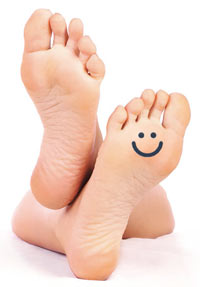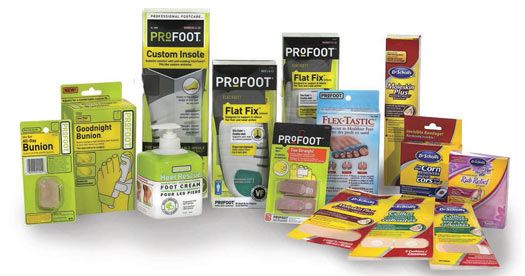It’s time to squeeze your tender tootsies into boots again…and for bunions, corns and calluses to make their annual appearance…

After a summer of foot-freedom, it’s time for socks, shoes and boots. That often means footwear that’s tight or rigid enough to cause pressure and friction, or even alter the way your bones are positioned within the framework of your feet. Let’s take a look at the three most common foot complaints and what can be done to prevent or alleviate them.
Bunions
A bunion is the enlargement of the joint at the base of the big toe. It develops as the result of misalignment and instability of the bones of the big toe. This leads to stretching of the ligaments and tendons around the joint and causes soft tissues over the joint to become inflamed and painful. Sometimes, there may be additional bone formation—known as exostosis— in the joint, causing the skin that covers the joint to become red and tender. In extreme cases, the big toe joint becomes so deformed that the toe lies either over or under the second toe. When a bunion has advanced this far, surgery is necessary.
Over time, a moderate bunion may make it diffcult to enjoy physical activities such as walking, running or dancing, but there are ways to prevent bunions from worsening.
What are the causes?
A number of factors can give rise to bunions, including:
- A family history of the condition
- Wearing improperly ftting shoes (especially narrow or high-heeled shoes)
- Certain arthritic conditions or ligament disorders
- Age (the incidence of bunions increases with age)
- Over pronation of the feet (rolling over to the inside)
- Nerve conditions affecting the foot
Prevention and relief:
In most cases, bunions can be reduced or relieved without surgical intervention. Reducing pressure on the bunion is the frst step in reducing pain and this begins with wearing shoes that ft properly.
Since the development of bunions is linked with instability of the big toe joint, helping the feet remain stable inside footwear can help relieve tension on the base of the big toe and prevent flat-footedness. You can also purchase devices specially designed for bunion relief during your working day, or for corrective use at night.
Bunion surgery (bunionectomy):
The primary goal of bunion surgery is to realign the big toe joint to relieve symptoms, correct deformity and restore function. There are many variations of bunionectomy and the type of surgery performed depends on the degree of deformity, the patient’s age, strength of the bones, and the preferred approach of the surgeon.
Most surgery involves removing the bony outgrowth (exostosis) and realigning the bones of the joint. The ligaments and tendons may also be repositioned. Sometimes, the insertion of screws and pins may be necessary to stabilize the bones in their realigned position.
If you have diabetes…
If you have diabetes, it is very important to care properly for your feet. In the case of diabetes, what appears to be a simple callus or corn can actually be a thin layer of hard skin covering a much deeper wound or ulceration.
Never attempt to remove a corn or callus yourself, including using salicylic acid. If your skin tends to heal slowly, even one application of a product containing salicylic acid can cause a wound that can take months or years to heal. When calluses or corns cause problems, see your family physician or podiatrist for advice and appropriate treatment.
Corns
Most of us are familiar with corns—small areas of skin that have become thickened due to pressure from ill-ftting shoes or socks. Although most corns are simply cosmetically undesirable, they can become painful when they press into the deeper layers of the skin.
There are actually two kinds of corn: hard corns and soft corns. Hard corns are commonly found on the top of the smaller toes or on the outer side of the little toe—the areas where poorly ftted shoes tend to rub most.
Soft corns tend to form between the toes as the result of the toes pressing against each other. They remain soft because sweat between the toes keeps them moist.
Prevention and relief:
making sure your shoes ft properly is the best way to prevent corns. Tight-ftting shoes with narrow toe boxes and/or inside seams are the worst culprits. Too-tight socks can also give rise to corns.
Applying self-adhesive moleskin or other protective cushioning can help prevent corns from developing. It is also a good idea to “rotate” your shoe types, to prevent consistent pressure on one or more specifc areas.
If you already have a corn, applying a corn remover or corn pad will help alleviate it. There are also liquid preparations (salicylic acid) that will remove the uppermost layers of skin to provide relief.
Calluses
Similar to corns, calluses are thickened areas of skin with a rough or waxy appearance. They are particularly common on the balls of the feet and the heels. Calluses are usually larger than corns and are rarely painful. However, many people dislike their appearance and so wish to remove them.
What are the causes?
Calluses are caused by friction or pressure to the sole or sides of the feet and, once again, ill-ftting shoes or socks that are too tight are usually to blame. Calluses also form over time as a result of frequent/intense walking or running.
Prevention and relief:
 Calloused feet can often be addressed in the bath or shower, by using a specially designed fle or pumice (London Drugs carries a variety of these implements, as well as creams formulated to soothe and soften calloused skin, in the foot care aisle). You may also choose to apply a callus removing pad which, like a corn remover, uses salicylic acid to remove keratinized (dead) skin. Applying molefoam or moleskin will also alleviate pressure and friction from shoes.
Calloused feet can often be addressed in the bath or shower, by using a specially designed fle or pumice (London Drugs carries a variety of these implements, as well as creams formulated to soothe and soften calloused skin, in the foot care aisle). You may also choose to apply a callus removing pad which, like a corn remover, uses salicylic acid to remove keratinized (dead) skin. Applying molefoam or moleskin will also alleviate pressure and friction from shoes.

Profoot® All-Day Bunion and Goodnight Bunion™ will provide relief and correction for uncomfortable bunions.Dr. Scholl’s® footcare line includes a wide variety of products for corns and calluses.

